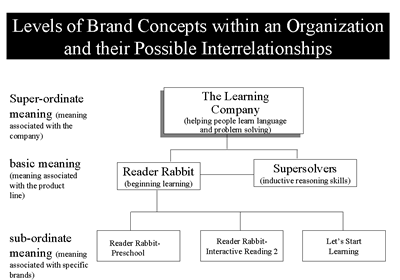Branding is such a fundamental part of marketing that it is worth understanding it completely. In this tutorial on branding, we discuss the basics. In other tutorials we extend these basics to look more in-depth at other important aspects of branding.
THE BRAND CONCEPT
The first idea when thinking about brands and branding is to understand what is a "brand concept". In essence, a brand is a set of associations that are linked to a brand, a division, or company. These associations reside in the memory of customers. These associations help customers understand what the brand or company is, why it is potentially relevant to them, how it is different or similar to other products made by the company, and how it is similar or different from competitor’s products.
LEVELS OF THE BRAND CONCEPT
Within a company there are different levels of brand concepts, and they are all inter-related. To see this, consider the Learning Company and their various product lines in the figure below.
At the highest, company level, are meanings associated with the company (psychologists call this the "super-ordinate meaning"). The products of companies are often structured into product lines, and the Learning Company has two of these basic product lines. Brand names can be associated with these product lines. Finally, meaning can be associated with specific brands.

WHERE DO BRAND ASSOCIATIONS COME FROM?
You might wonder where these associations come from. In fact, they come from various actions of the firm, including (but not limited to) the advertising and general media communications. But they also come from distribution (e.g., shelf location can convey a good product by a big seller), sales promotions (e.g., affordable), and product characteristics (including the name, packaging, and logo). Consumers' usage of these brands, and information about the brands from the press, opinion leaders, and word of mouth also affect the nature of these associations.
Researchers have various ways to uncover these brand associations. They might, for example, try to find out whether the brand concept is active in customer’s memory by using techniques of brand name recall or recognition. Other techniques like asking consumers to recall the associations they link to the brand or asking them to think of the brand as a person and describe what kind of person it would be would be examples of techniques designed to get at what specific associations are salient in consumers' minds and hence strongly linked to the brand name.
BRAND EXTENSIONS
When thinking about extending a brand or company name to a novel product category (e.g., Let's say Hi-C, known for its fruit drink, decides to make Hi-C hard candies), one of the things managers need to think about is whether consumers will accept this new brand based on the name it has. The central concept here is the extent to which consumers perceive a fit between the original brand concept and the new product. Indeed, consumers make inferences about the new brand based on the name it has, and if the name doesn't fit the product, consumers wont' think the brand is very good. The Hi-C name may be perceived to fit well with hard candies because the name evokes associations (fruity, sweet, fun), that should be relevant and desirable in hard candies. Read the tutorial on Brand Extensions for a more in-depth view of this subject.
THE BASES OF FIT
Now, you might ask, what are the bases on which fit is judged? There are several. On the one hand, consumers may find that a brand name fits a new product well because the features associated with the original brand are very similar to the features associated with the new product category. Tropicana, known for its orange juice may fit well on a new juice bar because orange juice and juice bars share many similar features.
Fit may also be judged to be high when the original brand and the new brand are complementary. Using the name Irish Spring (known for soap) on deodorant, using the Tostidos name (known for tortilla chips) on salsa, and using the name Kodak (known for film) on disposable cameras would create perceptions of high fit because the original product and the new product are complements. Finally, consumers may find that a brand name fits a new product well because the concept associated with the original brand fits well with the concept of the new brand. Consider a company like Ralph Lauren (known to product very fashionable clothes). Using the Ralph Lauren name on a line of Ralph Lauren Home products makes sense because this is a context in which consumers would find fashion relevant. Note that here, the fit is at a relatively broad concept level as opposed to a more specific attribute level. Of course, a brand extension can have multiple bases for fit. Vidal Sassoon (known for shampoo and for its "designer hairstyle" concept) fits with hairbrushes because shampoo and hairbrushes are complements and because hairbrushes are products which can benefit from a designer hairstyle concept.
APPLYING THE CONCEPTS
For different segments, brand names are different because they care about different benefits and therefore there is little fit (or the firm just wants the products to be distinct).
Within a segment, but where you have different descriptors, customers care about the same thing but may use a product in different ways (but the benefit fit is still OK). In this case, you may have one brand name but tailored for different uses. For example, Microsoft Office (where a "bundled product" is desired) has a Professional and Small Business Edition to appeal to different descriptors.
With this as a foundation you can also think about various brand systems, including line extensions (where an original brand, say Click Art 40,000, is extended into several different product (Click Art www.art, Click Art Handwritten Fonts, etc.).
Family Brands typically have a central name (e.g., Toyota) and a set of products and product lines that all use the central brand name.
You will also see Independent Brand Systems where the corporate concept is quite different from the specific brands. Intuit is a good example of this, where Intuit is the corporate brand, and Quicken represents the specific brands.
OTHER CONSIDERATIONS
Finally, there are quite involved brand systems that are actually combinations of corporate brands, family brands, independent brands, and extensions. But the way to think about the best way of organizing the brands and their inter-relationships is to think about and understand the various brand associations and the ways they fit together. Here are some specific questions to ask when thinking about this issue:
- Will the brand concepts (i.e. associations) interfere with one another?
- Will poor performance of one brand transfer to another?
- Will the system create confusion among novice consumers?
- Will brands in the same category compete with one another?
- Will the system cause cannibalization?
- Does the system impose restrictions on future products?
- Does the system allow for communication of company expertise in a single category?
- Will favorable attitudes of one brand (perhaps the most successful brand) transfer to another?
- Are the brand concepts mutually reinforcing?
- Does the system create organizational problems that can be solved?




